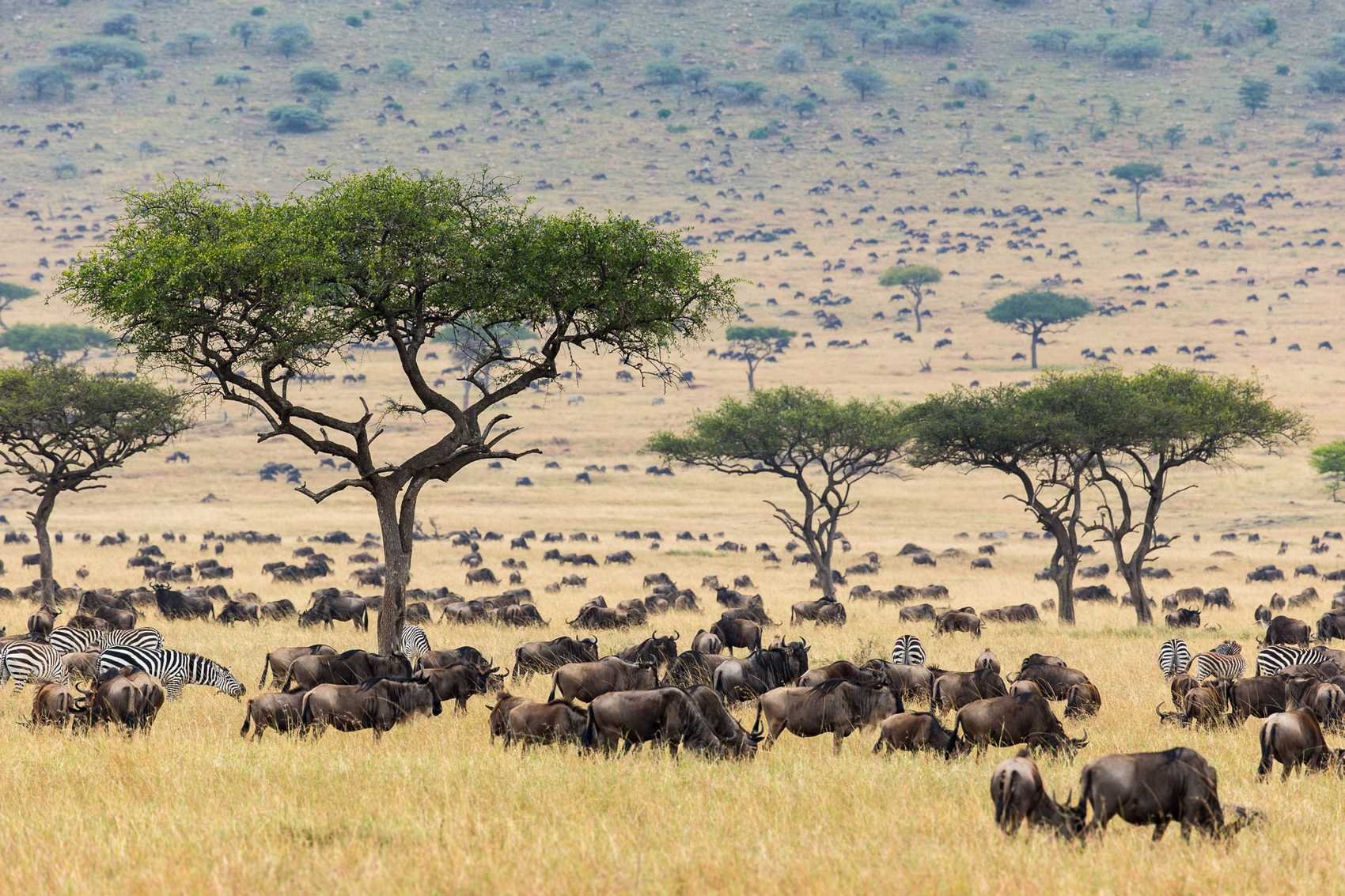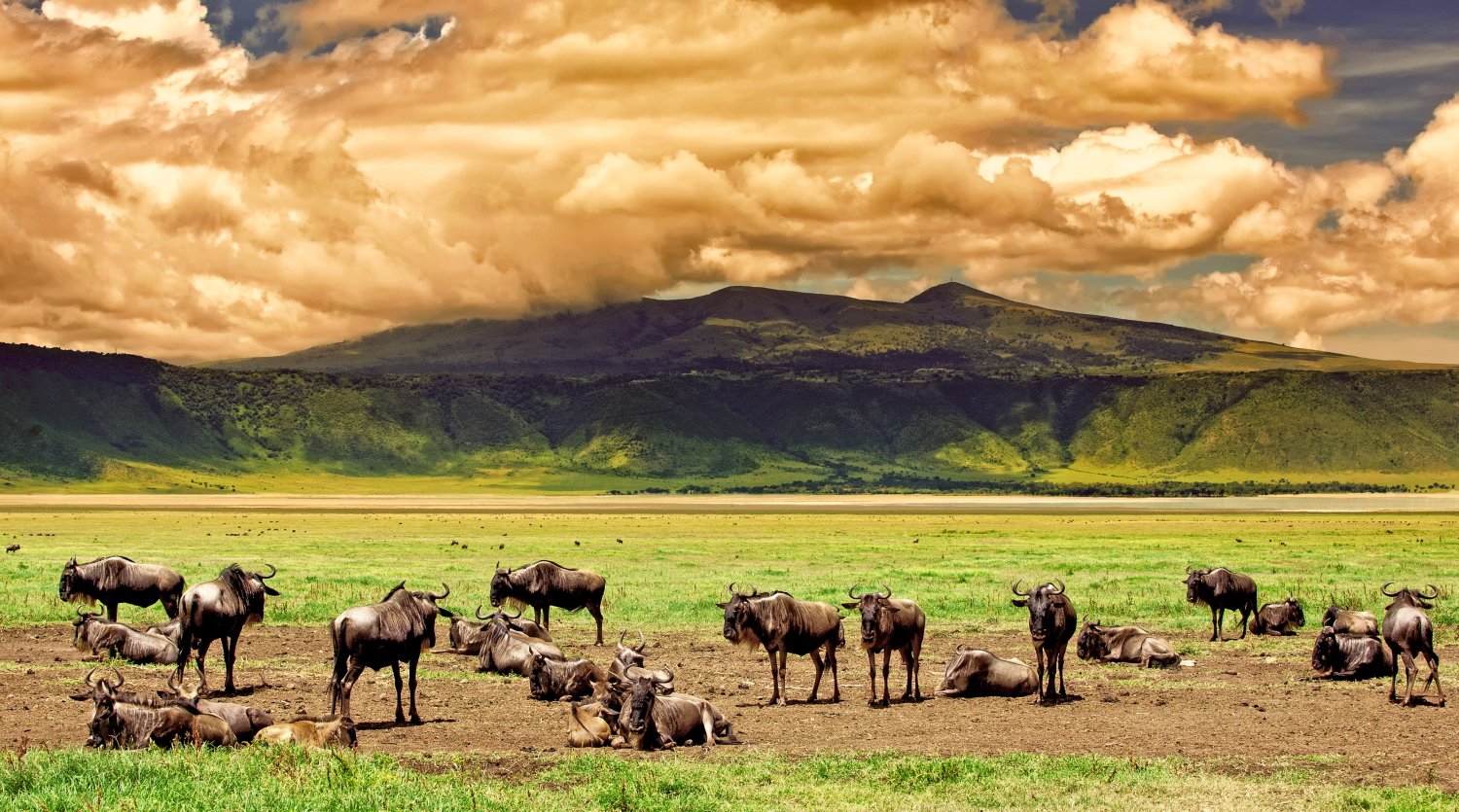
National Parks
Kenya's national parks are a testament to the breathtaking diversity and natural beauty that this East African nation has to offer. From the sweeping savannahs to lush forests and towering mountains, Kenya's national parks are a mosaic of landscapes waiting to be explored.
Aberdare National Park
Aberdare National Park is located about 100 km north of Nairobi and stretches over a wide variety of terrain at altitudes from 6,600 ft to 13,000 ft. and covers an area of 766 square kilometers that forms part of the Aberdare Mountain Range. The park contains a wide range of landscapes - from mountain peaks that rise to above sea level, to their deep, v-shaped valleys intersected by streams, rivers, and waterfalls. Moorland, bamboo forests and rainforests are found at lower altitudes.
Wildlife present in the protected area include lion, leopard, elephant, East African wild dog, giant forest hog, bushbuck, mountain reedbuck, waterbuck, Cape buffalo, suni, side-striped jackal, eland, duiker, olive baboon, black and white colobus monkey, and sykes monkey. Rarer sightings include those of the African golden cat and the bongo. Species such as the common eland, serval live in the higher moorlands. The Aberdare National Park also hosts a large eastern black rhinoceros population and over 250 bird species including the endangered Aberdare cisticola, Jackson's spurfowl, sparrowhawk, African goshawk African fish eagle, sunbirds and plovers.
Amboseli National Park
Amboseli National Park offers one of the finest wildlife viewing experiences in Kenya and Africa at large. Amboseli National Park lies immediately north-west of Mount Kilimanjaro, on the boarder of Kenya-Tanzania. The Park stretches over an area of 392 square km, and forms part of the much larger 3,000 sq km Amboseli ecosystem. Amboseli and the neighboring areas are mainly settlement areas of the Maasai warriors. The park is famous for being the best place in Africa to get close to the concentration of free-running elephants and the best view of Mount Kilimanjaro. Amboseli is a home to over 425 bird species, as well a variety of mammals, including elephants, buffalos, cheetahs, lions, zebras, jackals, hyena, wildebeests, baboons, oryx, gerenuk, impala, and grant’s gazelle.
Hell’s Gate National Park
Hell's Gate National Park lies south of Lake Naivasha in Kenya, north west of Nairobi. Hell's Gate National Park is named after a narrow break in the cliffs, once a tributary of a prehistoric lake that fed early humans in the Rift Valley. A small national park, it is known for its wide variety of wildlife and for its scenery. In the early 1900s, Mount Longonot erupted, and ash can still be felt around Hell's Gate. Hell's Gate National Park covers an area of 26 sq miles, relatively small by African standards. Though the park is considered small and the animals there are few in number, there is nevertheless a great diversity of species present. The park has historically been an important home for the rare lammergeyer vultures. There are over 103 species of birds in the park, including vultures, Verreaux's eagles, augur buzzard, and swifts. Some other common animals are Hyrakea, African buffalo, zebra, eland, hartebeest, Thomson's gazelle, hyena, and baboons. The park is also home to serval and small numbers of kilpspringer antelope and Chanler's mountain reedbuck.
Lake Nakuru National Park
Lake Nakuru National Park is one of the most spectacular of the many national parks in Kenya, as Lake Nukuru itself is one of the Rift Valley Soda Lakes that support highly specialized species. Once you pass through one of the three main gates into the park you will encounter a wide variety of wildlife species — especially the Flamingos which make the whole lake look pink. Nakuru National Park is famous for these flamingos that live on the shores of the lake.
Flamingos are not the only birds that make Lake Nakuru Park their home. It is known as a bird lover’s hub, home to over 400 bird species. These species include the African Fish Eagle, slender-billed greenbul, long-tailed widow bird, rufous-throated wryneck, montane white-eye, red-capped lark, northern puffback, Rüppell’s robin-chat, shining sunbird and more.
Nakuru National Park, though famous for the numerous birds, it’s also a wild game destination for animal lovers and wildlife explorers. It is a premium game park, one of only three in Kenya and one of the most visited game parks in this region of Africa. The park is home to over 100 endangered rhinos, distributed between the black and white rhinos. The endangered Rothschild’s giraffe also finds sanctuary at the park, along with dozens of other animal species that include buffalos, waterbucks, lions, impalas, and many more.
Maasai Mara Game Reserve
Maasai Mara Game Reserve is the largest and most popular reserve globally, especially during the great migration that occurs July-August and October-November. It has a wide variety of wildlife, including wildebeest, giraffes, zebras, leopards, lions, cheetahs, thompson’s gazelle, hyenas and more. Hippos and crocodiles dominate the Mara River, especially during the migration, so as to feast on the wildlife that journey in search of new pastures. There are also Massai villages near the reserve and one may spot some Maasai men herding cattle
Mount Kenya National Park
Mount Kenya National Park was established in 1949 to protect Mount Kenya, the wildlife there, and the surrounding environment which forms a habitat for that wildlife, as well as acting as catchment area for supplementing Kenya's water supply.Initially it was a forest reserve before being made a national park. Now the national park is encircled by the forest reserve. The park comprises an area of 276 sq. miles containing pristine wilderness with lakes, tarns, glaciers, dense forest, and mineral springs. Also present are rare and endangered species of animals, high-altitude adapted plains game, and unique montane and alpine vegetation. Animals that can be found on Mount Kenya National Park include elephants, tree hyrax, white-tailed mongoose, suni, black-fronted duiker, mole rat, bushbucks, water buck, elands, and over 130 different bird species. If you are lucky, you may see a leopard, bongo, or a giant forest hog.
Nairobi National Park
Nairobi National Park was established in 1946 and is located about 4.3 miles south of Nairobi. It is fenced on three sides, with an open southern boundary that allows migrating wildlife to move between the park and the adjacent Kitengela plains. Nairobi National Park is negatively affected by increasing human and livestock populations, changing land use, and poaching of wildlife. Despite its proximity to the city and its relativel small size, it boasts an astonishingly large and varied wildlife population and is one of Kenya's most successful rhinoceros sanctuaries. You can also find wide open grass plains against a backdrop of Nairobi's skyscrapers. Acacia bushes scattered throughout the park play host to a wide variety of wildlife including the endangered black rhino, lions, leopards, cheetahs, hyenas, buffaloes, giraffes, and diverse birdlife, with over 400 species recorded.
Ngorongoro Conservation Area
The Ngorongoro Conservation Area spans vast expanses of highland plains, savanna, savanna woodlands and forests. Established in 1959 as a multiple land use area, with wildlife coexisting with semi-nomadic Maasai pastoralists practicing traditional livestock grazing, it includes the spectacular Ngorongoro Crater, the world’s largest caldera. The property has global importance for biodiversity conservation due to the presence of globally threatened species, the density of wildlife inhabiting the area, and the annual migration of wildebeest, zebra, gazelles and other animals into the northern plains. Extensive archaeological research has also yielded a long sequence of evidence of human evolution and human-environment dynamics, including early hominid footprints dating back 3.6 million years.
Samburu National Reserve
Samburu National Reserve is situated at the southeastern corner of Samburu District in the Rift Valley Province of Kenya. It is bordered south by Ewaso Nyiro River, which separates it from the Buffalo Springs National Reserve. Samburu is home to the "Samburu Special 5": Grevy zebra, Somali ostrich, reticulated giraffe, gerenuk and the beisa oryx, unusual creatures not found in the Southern reserves. This craggy, rugged region unfolds a romantic, awe-inspiring experience for visitors. Captivating Samburu elephant herds saunter over this game rich reserve and big cats prowl through thick acacia forest.
Shimba Hills National Reserve
Shimba Hills National Reserve is a small National Reserve in the former Coast Province of Kenya. It is an area of coastal rainforest, woodland and grassland. The reserve is an important area for plant biodiversity – over 50% of the 159 rare plants in Kenya are found in the Shimba Hills, including some endangered species of cycad and orchids. It is also a nationally important site for birds and butterflies. There are estimated to be approximately 700 elephants in the reserve. Other animal species found in Shimba Hills are the Sable antelope, elephant shrew, bushy tailed mongoose, and other small mammals like fruit bats.
Tsavo National Park
Tsavo National Park, the largest national park in Kenya, comprises two separate areas: Tsavo East National Park and Tsavo West National Park. Tsavo is in the Coast Province of Kenya in between Nairobi City and Mombasa. The park is particularly well known for its large herds of elephants and captivating landscapes. It is one of the less populated game areas in Kenya and is perfect for those who want to enjoy a pristine wildlife experience. Tsavo National Park is nicknamed the "theatre of wildlife" or "land of man-eaters" due to its record-breaking population of animals.











